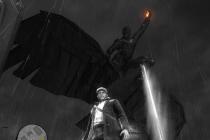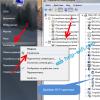Types and types of propulsion systems
TOPIC 1. GENERAL INFORMATION AND CONCEPTS ABOUT PROPELLER ELECTRIC UNITS
Ship power plants consist of an energy source located on the ship, a transmission mechanism and a mechanical propeller that converts mechanical energy of rotation into the energy of the ship's translational motion.
Energy sources on ships are mainly heat engines - diesels and steam or gas turbines. In them, fuel energy or thermal energy is converted into mechanical energy.
The transfer of energy from heat engines to ship propellers can be mechanical, hydraulic or electrical.
Installations with electrical transmission of energy to propellers are called propeller electric installations - GEM.
Reliable and economical propulsion systems are installations that include low-speed (low-speed) diesel engines 1 (Fig. 1.1) connected directly to the propeller shafts, on which the propellers are located. The thrust force developed by the propeller 3 is transmitted to the ship's hull through the thrust bearing 2.
Figure 1.1. Diesel rowing machine
On ships with high-power power plants and on high-speed passenger liners, propellers 3 are driven into rotation by steam turbines 1 with gear reducers 4 (Figure 1.2). They are called turbo-gear units (TZA).

Figure 1.2. Rowing plant with a steam turbine
On ships with nuclear power plants, thermal energy from nuclear reactors is converted into mechanical energy also with the help of heat engines - steam or gas turbines. Nuclear power plants (NPP) are much more complex than other plants, have a high degree of automation, and require a larger number of qualified service personnel. The use of nuclear power plants is justified for large-capacity tankers and icebreakers, because at the same time, the useful volume increases, the autonomy of navigation and the downtime required for refueling is reduced.
Rowing electric installations (GEM) consist of heat engines 1 (Fig. 1.3), which operate on generators 2, direct or alternating current 2, the electric power of the generators is supplied to the propulsion motors 3, through the control panel 4.

Figure 1.3. Electric propulsion system diagram
Propeller motors are connected to propellers (most often with propellers).
Also in the power plant circuit there is an excitation system 5. The control post of the power plant 6 is designed to control the power plant circuit through manual or automated control systems 7.
Power plants allow to reduce noise, often change the speed and direction of movement, and the power plant can also be used to power other ship mechanisms.
1.3. Requirements for the power plant. Advantages and disadvantages of the power plant.
The power plant, like all ship equipment, must have high reliability and reliability, as well as have a simple device and be safe for maintenance. The power plant should not completely fail and cause the ship to stop in case of damage to one heat engine, generator, electric motor or their control system.
Advantages of GEM in comparison with other types of transmission:
For the power plant, heat engines with a high rotational speed are used, which reduces the mass.
The lack of direct connection of the shaft of the heat engine with the propeller shaft allows to optimize the mode of operation and dimensions of the ship propulsion unit and to reduce the length of the connecting shafts.
It is possible to switch generators and propeller motors (GED) in emergency situations to keep the vessel running.
Ease of control compared to other types of transmission;
High efficiency at low and medium travel;
In diesel - electric power plants, the aggregate repair method can be used (each unit is repaired by their own specialists at the same time).
The power plant application eliminates the transmission of propeller vibration and shock to heat engines
Along with the advantages of the power plant, there are also disadvantages:
1.- With electrical transmission, additional losses appear in generators and GED, which reduce efficiency - 5-8%
2.- The use of a power plant without automatic control requires an increase in service personnel.
3.- Power plants have increased operating costs, but this is often offset by an increase in payload.
Power plants, in which power from the main engines is transmitted to the propellers by means of power transmission, is usually called propulsion electric plants (GEM).
The electric transmission makes it possible to ensure the fulfillment of one of the main requirements for the power plant of the icebreaker - the preservation of the constancy of the power of the main engine with changes in the moment on the propeller.
1. Gau classification
Rowing electrical installations (GEM) can be classified as follows
signs:
by the nature of the current - alternating, direct and alternating-direct current (double
a certain kind of current);
2. by the type of prime mover - diesel-electric, turbo-electric and gas-turbo-electric;
3. according to the control system - with manual control and with automatic control -
4.by the method of connecting the propeller motor with the propeller - with a direct connection
and with a toothed connection.
In rowing electric installations of direct current, as the main generators
generators with independent excitation are used to torors, and motors with independent excitation are used as propulsion electric motors.
In rowing electric installations of alternating current as the main generators
Synchronous machines are used as propeller motors, and synchronous or asynchronous machines are used as propeller motors.
The advent of powerful controlled semiconductor rectifiers led to the creation of an AC-DC power plant (double kind of current).
The advantages of AC-DC power plant are:
1. high reliability and efficiency of synchronous generators;
2.smooth and economical regulation of the propeller motor speed
a body controlled by a rectifier;
3. the ability to supply electricity to all ship consumers from the main generators (single AC power plant).
2. Gau DC
2.1. Basic information
Electric propulsion systems of direct current, in which the propulsion motors and the generators supplying them are direct current electric machines, differ
are simplicity, convenience and smooth regulation of the propeller rotation frequency in a wide range of their load moments.
DC power plants are used in installations of low and medium power on ships with high maneuverability. The power limitation of the power plant of direct current is determined
It is due to the fact that the creation of high-power electric machines on direct current is more difficult than on alternating current.
2.2. Schemes for switching on generators and propeller motors of a hydroelectric power plant
In the DC power plant, a number of options for the basic schemes for switching on generators and propeller electric motors are used. Some of them are shown in Fig.
Rice. 14.1. Connection diagrams of generators and motors in a DC power plant
Scheme with sequential inclusion generators and the engine armature (Fig.14.1, a) allows you to obtain an increased supply voltage to the engine, since the voltage
The generators are summed at the rated generator current.
For example, if the voltage of the generator is 600 V, then 1200 V will be supplied to the engine.
between any two points of the main current circuit of the GEM.
In a power plant with a series connection of generators, a dangerous emergency situation is possible if one of the prime movers loses fuel supply, for example, due to a jamming of the diesel fuel pump.
At the same time, the main circuit current continues to flow through the generator. A large negative moment is created on the generator shaft, which will stop the emergency primary motor.
and will start to rotate it in the opposite direction, which will lead to major damage to the diesel engine. This situation should be quickly detected by appropriate sensors (often
rotation, water pressure, oil pressure), which give out an emergency stop signal and both
de-excitation of the generator is sintered.
Scheme with parallel connection generators (Figure 14.1, b) provides convenience
in switching on and off individual generators.
If the generators are installed on one shaft, then the uniformity of their load will ensure
is relatively simple. If the generators have different prime movers, then an even distribution of the loads is achieved by additional measures, for example by introducing cross-links between successive field windings.
In fig. 14.1, c shows an example of a single-circuit power plant with a series connection of four generators and two motors. Such a scheme, in which a pair of generators and one engine alternate, allows the voltage between any two points of the circuit to be reduced to twice the voltage of one generator and thereby increase the safety
maintenance of the power plant.
A GEM of such a composition of generators and GED can also have a two-circuit structure: each electric motor is powered by its own pair of series (or parallel) connected generators. Two circuits of the power plant ensure greater reliability of the installation as a whole.
An electric propulsion system is the main propulsion system of a ship, which drives the propeller into rotation using an electric motor powered by a current generated by a generator. Installations of this type are used mainly on icebreakers, special-purpose ships, and submarines.
The largest vessel using an electric propulsion system is the ocean liner RMS Queen Mary 2, equipped with four 215 MW "Azipod" type mobile electric motors.
The electric transmission ensures that the power of the main engine remains constant with changes in the propeller torque.
Rowing electrical installations (GEM) can be classified according to the following criteria:
1. By the kind of current - alternating, direct and alternating-direct (double kind of current);
2. By the type of prime mover - diesel-electric, turbo-electric and gas-turbo-electric;
3. By control system - with manual and automatic control;
4. By the method of connecting the propeller motor to the propeller - with direct connection and with gear connection.
In DC propulsion electric installations, generators with independent excitation are used as main generators, and independent excitation motors are used as propulsion electric motors.
In rowing electric installations of alternating current, synchronous machines are used as main generators, and synchronous or asynchronous electric motors are used as propulsion electric motors.
The use of powerful controlled semiconductor rectifiers made it possible to create a dual current power plant.
The advantages of this type of power plant are:
- high reliability and efficiency of synchronous generators;
- smooth and economical regulation of the rotational speed of the propeller motor controlled by the rectifier;
- the ability to power all ship consumers from the main generators, i.e. from a single ship power plant of alternating current.
DC power plants are used in installations of low and medium power with high maneuverability. The limitation of the power of this type of power plant is determined by the complexity of creating high-power electric machines with direct current in comparison with machines with alternating current.
Such installations are distinguished by simplicity, convenience and smooth regulation of the rotational speed of the propellers in a wide range of their moments and loads.
AC power plants are installed on ships with relatively rare changes in the mode of movement.
They are characterized by the use of increased voltages: at a power plant of up to 10 MW - 3000 V, at high powers - up to 6000 V. The nominal current frequency is usually 50 Hz.
In AC power plants at low and medium powers (up to 15 MW), diesel engines are usually used as the primary engine, and at high powers, turbines.
Regulation of the rotational speed of propeller motors in AC power plants with fixed-pitch propellers is provided by changing the voltage frequency of the generators when changing the rotational speed of the prime movers, or by using asynchronous machines with a wound rotor as propulsion motors. Frequency control of the angular speed of AC propulsion motors turns out to be energetically advantageous, since it minimizes their electrical losses. Changing the direction of rotation of propulsion motors is achieved by switching phases in the main circuit, the number of which is usually three.
A method of regulating the operating mode of an AC power plant, which makes it possible to avoid the difficulties of regulating the rotation frequency of AC motors, is the use of variable pitch propellers (CPP).
GEMs of a double kind of current are called installations in which synchronous alternators are used as sources of electricity, and DC motors are used as propulsion motors.
The development of powerful rectifiers made it possible to combine the high maneuverability of the DC power plant with the advantages of the AC power plant, which consists in the use of high-speed prime movers and small weight and size indicators.
Semiconductor rectifiers of two types are used:
- uncontrolled, the output voltage of which is not regulated;
- controlled - with adjustable output voltage;
GEM of double kind of current with rectifiers provide:
- high maneuverability due to a wide range of regulation of the propulsion motor frequency;
- the possibility of creating turbine generator sets without gearboxes and the convenience of their layout in the engine room;
- reduction of noise and vibration of the power plant elements;
- increase in the overall efficiency installations;
- the greatest simplicity of execution and reliability of propeller motors.
The use of a CPP for a GEM of a double type of current brings additional advantages:
- the constancy of the rotation frequency of the generator motors;
- the constancy of the rotational speed of the propeller motor and propeller.
The constancy of the rotational speed of the primary engines of the power plant makes it possible to take power from the tires of the electric propulsion system for general ship consumers and more efficiently use the installed capacity of the ship power plant.
GEMs of a double type of current are superior in their characteristics to GEMs of both direct and alternating current.
The main task during the operation of the power plant is to ensure its trouble-free and trouble-free operation, constant readiness for action.
The solution to this problem is achieved when the following conditions are met:
- providing qualified service;
- timely replenishment of spare parts and materials;
- correctly determining the timing and scope of preventive and repair work performed by the ship's crew;
- carrying out extended tests and organizing the adjustment of the power plant in accordance with the intended purpose of the vessel;
- constant monitoring of the degree of contamination of insulating surfaces in electrical machines of the power plant;
- checking the condition of cables and sealing their endings.
Thus, the complex of technical operation measures covers the maintenance, care and repair of the power plant and its elements.
Bibliography
1. Akimov V.P. Ship automated power plants, "Transport", 1980.
2. Handbook of ship mechanic (in two volumes). Ed. 2nd, rev. and add. Under the general editorship of Cand. tech. L.L. Gritsaya. M., "Transport", 1974
3. Zavisha V.V., Dekin B.G. Ship auxiliary mechanisms., M., "Transport", 1974, 392 p.
4. Kiris O.V., Lisin V.V. Thermodynamics and heat engineering. Navchalnyy pos_bnik. At 2 o'clock, Part 1: Thermodynamics. - Odessa: ONMA, 2005 .-- 96 p.
5. Ovsyanikov M.K., Petukhov V.A. Ship automated power plants. "Transport", 1989.
6. Taylor D.A. Basics of ship technology. "Transport", 1987.
7. Methodical instructions to the submission of laboratory robots in the discipline "Ship power installations and electrical equipment of ships." Odesa: ONMA, 2012.
8. Vereskun V.I., Safonov A.S. Electrical engineering and electrical equipment of ships: Textbook. - L .: Shipbuilding, 1987 .-- 280 p., Ill.
Thousands of people around the world are involved in repairs every day. When performing it, everyone begins to think about the subtleties that accompany the repair: in what color scheme to choose wallpaper, how to choose curtains in the color of the wallpaper, correctly arrange furniture to obtain a single style of the room. But rarely does anyone think about the most important thing, and this is the main thing to replace the electrical wiring in the apartment. After all, if something happens to the old wiring, then the apartment will lose all its attractiveness and become completely unsuitable for life.
Any electrician knows how to replace the wiring in an apartment, but any ordinary citizen can do this, however, when performing this type of work, he should choose high-quality materials in order to get a safe electrical network in the room.
The first action to be taken is plan future wiring... At this stage, you need to determine exactly where the wires will be laid. Also at this stage, you can make any adjustments to the existing network, which will make it possible to arrange the lamps and in the most comfortable way in accordance with the needs of the owners.
12.12.2019
Narrow-branch devices of the knitted sub-industry and their maintenance
To determine the extensibility of hosiery, a device is used, the diagram of which is shown in Fig. one.
The design of the device is based on the principle of automatic balancing of the rocker arm by elastic forces of the test product acting at a constant speed.
The weight rocker is an equal-armed round steel rod 6 with an axis of rotation 7. On its right end, legs or a sliding form of the track 9 are attached to its right end using a bayonet lock, on which the product is put on. A suspension for loads 4 is pivotally attached to the left shoulder, and its end ends with an arrow 5, showing the equilibrium state of the rocker arm. Before testing the product, the rocker arm is brought into equilibrium with a movable weight 8.

Rice. 1. Diagram of a device for measuring the extensibility of hosiery: 1 — guide, 2 — left ruler, 3 — slider, 4 — suspension for loads; 5, 10 - arrows, 6 - rod, 7 - axis of rotation, 8 - weight, 9 - track shape, 11 - tension arm,
12 - carriage, 13 - lead screw, 14 - right ruler; 15, 16 - helical gears, 17 - worm gear, 18 - coupling, 19 - electric motor
To move the carriage 12 with the stretching lever 11, a lead screw 13 is used, at the lower end of which a helical gear 15 is fixed; through it, the rotational movement is transmitted to the lead screw. The change in the direction of rotation of the screw depends on the change in rotation 19, which is connected to the worm gear 17 by means of a coupling 18. A helical gear 16 is mounted on the gear shaft, which directly imparts movement to the gear 15.
11.12.2019
In pneumatic actuators, the adjustment force is generated by the action of compressed air on the diaphragm, or piston. Accordingly, the mechanisms are diaphragm, piston and bellows. They are designed to position and move the control valve gate in accordance with a pneumatic command signal. The full working stroke of the output element of the mechanisms is carried out when the command signal changes from 0.02 MPa (0.2 kg / cm 2) to 0.1 MPa (1 kg / cm 2). The limiting pressure of compressed air in the working cavity is 0.25 MPa (2.5 kg / cm 2).
In linear-thrust diaphragm mechanisms, the rod reciprocates. Depending on the direction of movement of the output element, they are subdivided into mechanisms of direct action (with an increase in membrane pressure) and reverse action.

Rice. 1. The design of the direct-acting diaphragm actuator: 1, 3 - covers, 2 - membrane, 4 - support disk, 5 - bracket, 6 - spring, 7 - stem, 8 - support ring, 9 - adjusting nut, 10 - connecting nut
The main structural elements of the diaphragm actuator are a membrane pneumatic chamber with an arm and a moving part.
The diaphragm pneumatic chamber of the direct action mechanism (Fig. 1) consists of covers 3 and 1 and membrane 2. Cover 3 and membrane 2 form a sealed working cavity, cover 1 is attached to the bracket 5. The movable part includes support disk 4, to which the membrane is attached 2, a rod 7 with a connecting nut 10 and a spring 6. The spring at one end abuts against the support disk 4, and the other through the support ring 8 into the adjusting nut 9, which serves to change the initial tension of the spring and the direction of movement of the rod.
08.12.2019
Today there are several types of lamps for. Each has its own pros and cons. Consider the types of lamps that are most often used for lighting in a residential building or apartment.

The first type of lamps - incandescent lamp... This is the cheapest type of lamp. The advantages of such lamps include its cost, simplicity of the device. The light from these lamps is the best for the eyes. The disadvantages of such lamps include a short service life and a large amount of electricity consumed.
The next type of lamps is energy-saving lamps... Such lamps can be found for absolutely any type of base. They are an elongated tube in which there is a special gas. It is the gas that creates the visible glow. In modern energy-saving lamps, the tube can have a wide variety of shapes. The advantages of such lamps: low power consumption compared to incandescent lamps, daylight, a large selection of socles. The disadvantages of such lamps include the complexity of the design and flicker. The flickering is usually subtle, but the eyes will get tired of the light.
28.11.2019
Cable assembly- a kind of mounting assembly. The cable assembly consists of several local ones, terminated on both sides in an electrical installation shop and tied into a bundle. The installation of the cable route is carried out by laying the cable assembly into the cable route fastening device (Fig. 1).
Ship cable route- an electrical line mounted on a ship from cables (cable bundles), cable routing fixing devices, sealing devices, etc. (Fig. 2).
On the ship, the cable route is located in hard-to-reach places (along the sides, ceiling and bulkheads); they have up to six turns in three planes (Fig. 3). On large ships, the maximum cable length reaches 300 m, and the maximum cross-sectional area of the cable route is 780 cm 2. On individual ships with a total cable length of over 400 km, cable corridors are provided for placing the cable route.
Cable routes and cables passing through them are subdivided into local and trunk routes, depending on the absence (presence) of sealing devices.
Trunk cable routes are subdivided into routes with end boxes and pass-through boxes, depending on the type of use of the cable box. It makes sense for the choice of technological equipment and cable routing technology.
21.11.2019
In the field of development and production of instrumentation and automation devices, the American company Fluke Corporation occupies one of the leading positions in the world. It was founded in 1948 and since that time has been constantly developing and improving technologies in the field of diagnostics, testing, analysis.
Innovation from an American developer
Professional measuring equipment from a multinational corporation is used for servicing heating, air conditioning and ventilation systems, refrigeration units, checking air quality, calibrating electrical parameters. The Fluke brand store offers to purchase certified equipment from an American developer. The complete range includes:- thermal imagers, insulation resistance testers;
- digital multimeters;
- analyzers of the quality of electrical energy;
- rangefinders, vibrometers, oscilloscopes;
- calibrators of temperature, pressure and multifunctional apparatus;
- visual pyrometers and thermometers.
07.11.2019
A level gauge is used to determine the level of different types of liquids in open and closed storages and vessels. It is used to measure the level of a substance or the distance to it.
To measure the liquid level, sensors are used that differ in type: radar, microwave (or waveguide), radiation, electrical (or capacitive), mechanical, hydrostatic, acoustic.














